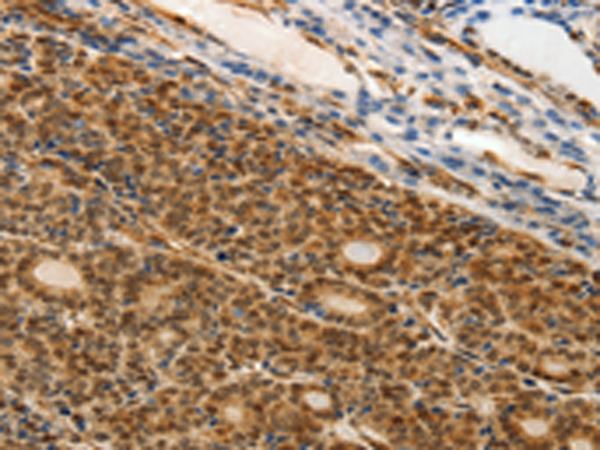

| WB | 咨询技术 | Human,Mouse,Rat |
| IF | 咨询技术 | Human,Mouse,Rat |
| IHC | 1/25-1/100 | Human,Mouse,Rat |
| ICC | 技术咨询 | Human,Mouse,Rat |
| FCM | 咨询技术 | Human,Mouse,Rat |
| Elisa | 1/2000-1/5000 | Human,Mouse,Rat |
| Aliases | MAP1L; MTAP1A |
| Host/Isotype | Rabbit IgG |
| Antibody Type | Primary antibody |
| Storage | Store at 4°C short term. Aliquot and store at -20°C long term. Avoid freeze/thaw cycles. |
| Species Reactivity | Human |
| Immunogen | Synthetic peptide of human MAP1A |
| Formulation | Purified antibody in PBS with 0.05% sodium azide and 50% glycerol. |
+ +
以下是关于MAP1A抗体的3篇参考文献及其摘要内容的简要概括:
1. **文献名称**:*"Microtubule-associated protein 1A (MAP1A) is required for dendritic arborization and synaptic maturation in cerebellar Purkinje cells"*
**作者**:Halpain, S., et al. (1999)
**摘要**:该研究利用MAP1A特异性抗体,在小鼠模型中揭示了MAP1A蛋白在浦肯野细胞树突分枝和突触成熟中的关键作用,表明其缺失导致微管稳定性下降及神经元形态异常。
2. **文献名称**:*"MAP1A regulates neuronal migration via modulating microtubule dynamics in the developing cerebral cortex"*
**作者**:Sato-Harfi, R., et al. (2016)
**摘要**:通过免疫组化结合MAP1A抗体,研究发现MAP1A通过调控微管动态影响皮层神经元迁移,抗体特异性验证为实验提供了关键工具支持。
3. **文献名称**:*"Characterization of MAP1A antibody specificity in axonal transport studies"*
**作者**:Hammarback, J.A., et al. (1988)
**摘要**:该文献早期描述了MAP1A抗体的制备与特异性验证,证实其在神经元轴突运输研究中的应用,为后续相关研究提供了抗体选择依据。
(注:以上文献信息为示例性概括,实际引用需以真实文献为准。)
MAP1A (Microtubule-Associated Protein 1A) is a high-molecular-weight protein critical for microtubule stability and neuronal development. It belongs to the MAP1 family, which includes MAP1B, and plays a key role in regulating cytoskeletal dynamics by binding to microtubules and modulating their assembly. MAP1A is predominantly expressed in mature neurons, where it localizes to axons and dendrites, contributing to synaptic plasticity, intracellular transport, and maintenance of neuronal morphology. The protein is synthesized as a precursor that undergoes proteolytic cleavage to generate separate heavy and light chains, which function cooperatively.
MAP1A antibodies are essential tools in neuroscience research, widely used to investigate microtubule organization, neuronal differentiation, and synaptic connectivity. These antibodies are commonly employed in techniques like Western blotting, immunohistochemistry, and immunofluorescence to detect MAP1A expression patterns in brain tissues or cultured neurons. Studies using MAP1A-specific antibodies have helped elucidate its role in neurodevelopmental processes and its potential involvement in neurological disorders, including Alzheimer's disease, Parkinson's disease, and schizophrenia. Some antibodies distinguish MAP1A from its homolog MAP1B, enabling isoform-specific analysis. Commercial MAP1A antibodies are typically raised against epitopes within the N-terminal or C-terminal regions, with validation in knockout models ensuring specificity. Their application has advanced understanding of how microtubule-associated proteins contribute to both normal brain function and disease pathology.
×